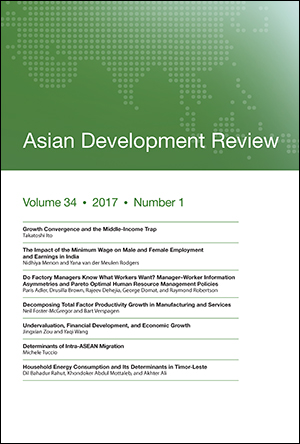Erratum: Wage Differentials between Foreign Multinationals and Local Plants and Worker Quality in Malaysian Manufacturing
“Wage Differentials between Foreign Multinationals and Local Plants and Worker Quality in Malaysian Manufacturing” by Eric Ramstetter Volume 31, Issue Number 2, page 70
The printed table has missing variable names on the left-hand side of the table. The table should appear as follows:
| Pooled OLS | Random Effects | ||||||
|---|---|---|---|---|---|---|---|
| Lagged | Contemporaneous | Lagged | Contemporaneous | ||||
| Slope coefficient variable, indicator | 2001–2004 | 2001–2004 | 2000–2004 | 2001–2004 | 2001–2004 | 2000–2004 | |
| LKE = capital intensity | 0.0242*** | 0.0329*** | 0.0338*** | 0.0183*** | 0.0360*** | 0.0367*** | |
| LO = output scale | 0.1071*** | 0.1178*** | 0.1187*** | 0.1032*** | 0.1229*** | 0.1264*** | |
| SH = highly paid share of paid workers | 0.0074*** | 0.0070*** | 0.0082*** | 0.0037*** | 0.0061*** | 0.0074*** | |
| S3 = highly educated share of all workers | 0.0064*** | 0.0072*** | 0.0060*** | 0.0042*** | 0.0064*** | 0.0049*** | |
| S2 = moderately educated share of all workers | 0.0011*** | 0.0011*** | 0.0005*** | 0.0006*** | 0.0007*** | 0.0001 | |
| SF = female share of paid workers | −0.0039*** | −0.0035*** | −0.0036*** | −0.0032*** | −0.0026*** | −0.0025*** | |
| DF = MNE–local differential (ratio less 1) | 0.0890*** | 0.0809*** | 0.0913*** | 0.0749*** | 0.0525*** | 0.0658*** | |
| R2 | 0.5591 | 0.5735 | 0.5638 | 0.5454 | 0.5683 | 0.5579 | |
| Observations | 21,671 | 26,855 | 34,491 | 21,671 | 26,855 | 34,491 | |
| Breusch-Pagan Test | – | – | – | 8,254*** | 10,202*** | 14,135*** | |


